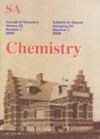含Co(II)、Ni(II)离子的5-偶氮苯基水杨醛单核席夫碱配合物的合成、表征、电化学研究及抗菌性能
IF 1
4区 化学
Q4 CHEMISTRY, MULTIDISCIPLINARY
South African Journal of Chemistry-Suid-Afrikaanse Tydskrif Vir Chemie
Pub Date : 2019-01-01
DOI:10.17159/0379-4350/2019/V72A13
引用次数: 3
摘要
本研究合成了1,2-二[n -2-苯基硫-5-偶氮苯基水杨基]乙烷(H2L)、1,3-二[n -2-苯基硫-5-偶氮苯基水杨基]丙烷(H2L)和1,4-二[n -2-苯基硫-5-偶氮苯基水杨基]丁烷(H2L)。通过H2L、h2l2和h2l3与Ni(II)和Co(II)乙酸盐反应,制备了ML、ML和ML配合物。采用FT-IR、H-NMR、元素分析、电导率和磁性测量、ESI-mass、UV-Vis光谱和循环伏安法对所制备的配体及其配合物进行了表征。质谱数据显示,配合物具有单体结构。所有的配合物都具有六协调的八面体几何结构。用CV法研究了配体Ni(II)和Co(II)配合物在DMF中氩气氛下的电化学行为。结果表明,Ni(II)的配位导致配体失活。Co(II)配合物的伏安图表明,CoL的还原比CoL更难,且CoL是无活性的。对它们的抑菌活性进行了研究,发现配合物对选择性细菌的抑菌活性优于游离配体。本文章由计算机程序翻译,如有差异,请以英文原文为准。
Mononuclear Schiff Base Complexes Derived from 5-Azophenylsalicylaldehyde with Co(II), Ni(II) Ions: Synthesis, Characterization, Electrochemical Study and Antibacterial Properties
In the present research, 1,2-di[N-2-phenylthio-5-azophenylsalicylidene]ethane (H2L ), 1,3-di[N-2-phenylthio-5-azophenylsalicylidene]propane(H2L ) and 1,4-di[N-2-phenylthio-5-azophenylsalicylidene]butane (H2L ) were synthesized. ML, ML and ML complexes were prepared through the reaction of H2L , H2L 2 and H2L 3 with Ni(II) and Co(II) acetate salts. The prepared ligands and their complexes were characterized with FT-IR, H-NMR, elemental analysis, conductivity and magnetic measurements, ESI-mass, UV-Vis spectroscopy and cyclic voltammetry. The complexes had monomeric structure according to the mass spectral data. All of the complexes had a six-coordinated octahedral geometry. The electrochemical behavior of the ligands, Ni(II) and Co(II) complexes was investigated by CV in DMF under argon atmosphere. The results show that the coordination of Ni(II) causes the ligands to be deactivated. The voltammogram of Co(II) complexes shows that the reduction of CoL is harder than CoL and CoL is inactive. Their antibacterial activity was investigated and the complexes exhibited better antibacterial activity than the free ligands against selective bacteria.
求助全文
通过发布文献求助,成功后即可免费获取论文全文。
去求助
来源期刊
CiteScore
3.10
自引率
0.00%
发文量
6
审稿时长
>12 weeks
期刊介绍:
Original work in all branches of chemistry is published in the South African Journal of Chemistry. Contributions in English may take the form of papers, short communications, or critical reviews.

 求助内容:
求助内容: 应助结果提醒方式:
应助结果提醒方式:


